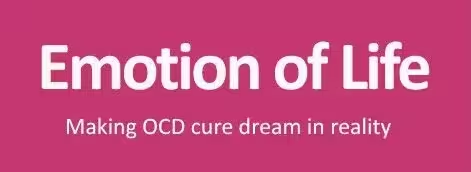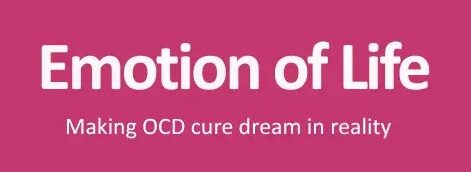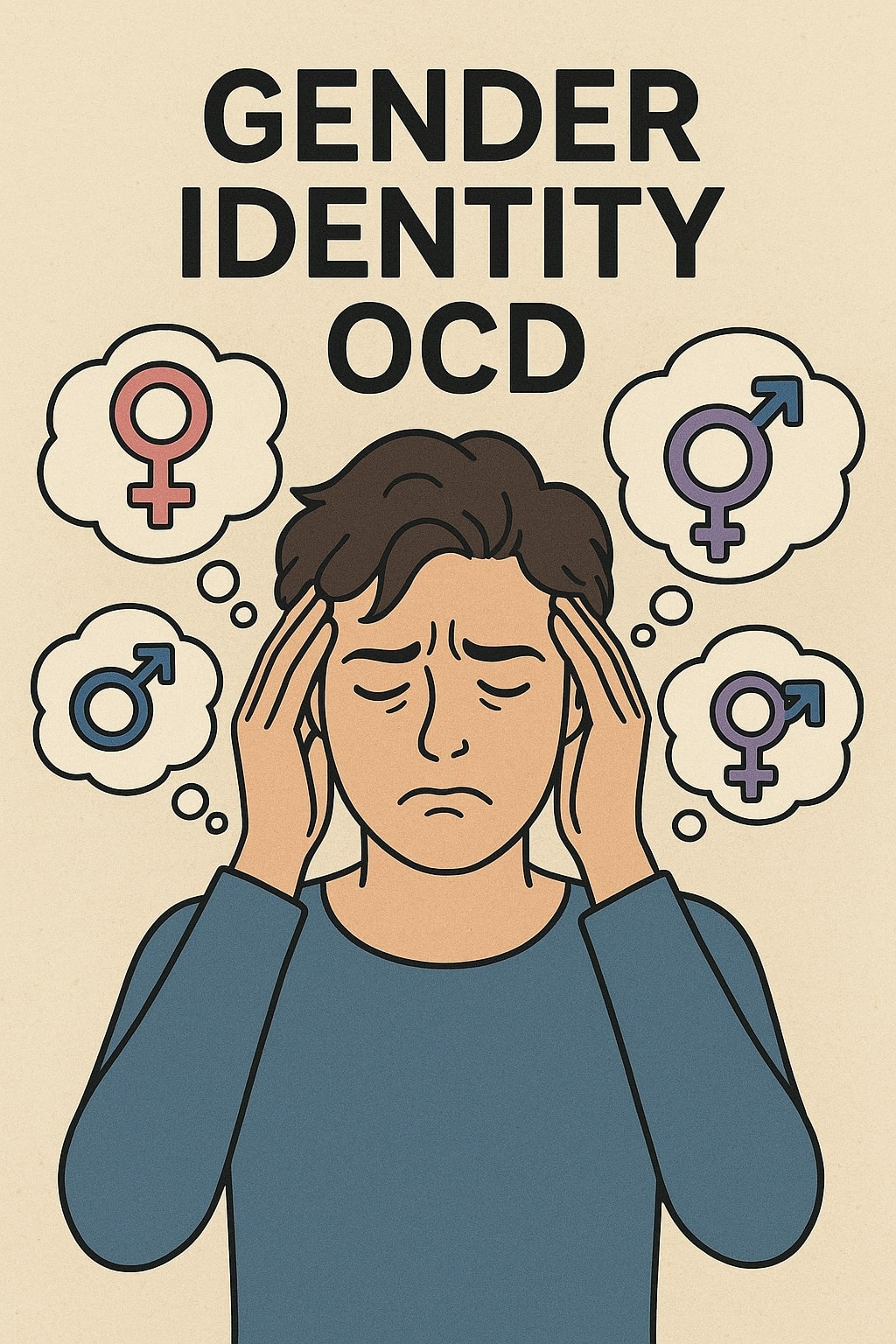Gender Identity OCD unlike healthy curiosity about one’s gender or natural exploration of identity, Gender Identity OCD is driven by unwanted, repetitive, and intrusive doubts it is one of the most confusing and overwhelming experiences an individual can go through. These thoughts come against the person’s will and cause intense distress.
For instance, a teenager might suddenly think:
- “What if I’m not really the gender I believe I am?”
- “What if I’ve been lying to myself all this time?”
- “What if others can see something about me that I can’t?”
These doubts don’t reflect the person’s true feelings or values. In fact, most people experiencing Gender Identity OCD are terrified of the thoughts and don’t want them at all. Yet, the more they fight them, the stronger and louder they become.
This constant unwanted Pattern can take over their daily life. A person may spend hours in front of the mirror, checking their appearance for signs of “proof,” or endlessly searching the internet for answers. Some even ask friends, family, or therapists the same questions again and again, hoping to feel certain.
At Emotion of Life, guided by Shyam Gupta and Pratibha Gupta, the journey of recovery is built on the principle of 100 days, 100 sessions, 100% recovery. Here, individuals are supported to separate their identity from OCD-driven fears, so they can move forward with confidence, clarity, and peace of mind.
Common Signs and Symptoms of Gender Identity OCD
Gender Identity OCD shows up in both thought patterns and behaviours. Common signs include:
- Intrusive doubts: Persistent questions like “What if I’m actually the other gender?” that pop into the mind and cause distress.
- Checking behaviours: Repeated mirror-checking, re-reading past messages, or re-watching videos of oneself to “look for proof.”
- Avoidance: Avoidance of clothes, bathrooms, social settings, or activities that trigger doubts.
- Reassurance-seeking: Constantly asking family, friends, or online groups “Do I look like a boy/girl?” or “Am I normal?” but the relief is temporary.
- Mental checking: Mentally replaying interactions to examine whether one behaved “like” a particular gender.
- Emotional effects: Shame, guilt, confusion, sleeplessness, concentration loss, and withdrawal from people and life routines.
These symptoms can be indirect at first, but they grow. The core problem is not the content of the thoughts (which can be about many things) it is the OCD process that turns a thought into a crisis.
How Gender Identity OCD Affects Children, Teens, and Adults
Gender Identity OCD can appear at any age, and it changes shape with life stage.
- Children: May ask repeated, worried questions to parents or teachers (“Am I a boy/girl?”), become clingy, refuse certain toys or clothes, or show sudden school refusal. Their distress may look like moodiness or tantrums.
- Teenagers: Often feel intense shame in front of peers. They may avoid sports, dance, or social groups and even any group activities, hide in their phones, or check their appearance for hours. Peer teasing or gossip can make the doubt louder and longer.
- Adults: Doubts can interfere with dating, career decisions, and close friendships. Adults may withdraw, avoid intimacy, or change jobs to escape triggers. The result is often exhaustion and sense of being “out of step” with life.
No matter the age, the effect is the same, energy and attention get pulled away from living and given to doubt, and the person loses trust in their own sense of self.
Difference Between Gender Dysphoria and Gender Identity OCD
- Gender Dysphoria is a sustained, consistent feeling that someone’s gender identity differs from the sex assigned at birth. It is an identity experience, often steady over time.
- Gender Identity OCD is marked by intrusive doubt. The person may have always felt fine in their gender, yet OCD forces repetitive questioning that causes distress. In Gender Identity OCD the person is usually terrified of the thought and does not want it.
Understanding the difference matters because the right support depends on whether the issue is an identity experience (dysphoria) or an anxiety/fear cycle (OCD). Misreading one for the other can delay the right help.
Causes and Triggers of Gender Identity OCD
Gender Identity OCD usually results from a combination of factors there is rarely one single cause:
Psychological contributors:
- A strong need for certainty; difficulty tolerating doubt.
- Perfectionism, high sensitivity to guilt, or black-and-white thinking.
Social contributors:
- Strict messages about gender roles from family, religion, or culture.
- Teasing, bullying, or being compared to others in childhood or school.
Environmental triggers:
- Big life changes (moving, starting university, new job, breakups).
- Exposure to intense online debates or content that encourages comparison or doubt.
Hence, recognising triggers helps shape an effective plan to manage them.
Effective Treatment Options for Gender Identity OCD
Treatment focuses on reducing the control of intrusive thoughts and on rebuilding life around values, not around doubt.
- Cognitive Behavioural Therapy (CBT) for Gender Identity OCD
CBT helps people notice how thoughts, feelings, and behaviours interact. It teaches practical ways to test beliefs and to reduce mental checking. Over time, CBT helps the mind treat intrusive thoughts as just thoughts not facts.
- Exposure and Response Prevention (ERP) for Gender Identity OCD
ERP is the core of OCD treatment. It means facing a feared situation (for example, wearing an outfit that triggers doubt or going to a social event) while resisting the urge to check or seek reassurance. Repeating this in a safe, gradual way reduces anxiety and the urge to compulsively check.
- Acceptance and Commitment Therapy (ACT) for Gender Identity OCD
ACT emphasises accepting that thoughts will come, learning not to fight them, and choosing actions aligned with what matters to the person (friends, work, creativity). It helps people move toward a meaningful life even when doubt appears.
- Wellness Counselling life philosophy and balance
This work supports sleep, exercise, social habits, and self-kindness. It helps people form a life philosophy that supports recovery rather than feeding doubt.
- Personality Dynamics and Development courses
Courses or coaching to strengthen self-concept, communication, and confidence so the person is not defined by intrusive doubts.
- Healthy coping strategies
Grounding, journaling, creative work, sports, and limiting unhelpful online searching.
At Emotion of Life, therapists such as Shyam Gupta and Pratibha Gupta combine these components into a structured OCD Therapy program, often framed around a steady recovery pathway like 100 days, 100 sessions, 100% recovery. The goal is not immediate certainty but steady freedom from the cycle of doubt.
Role of Parents in Supporting Children with Gender Identity OCD
Parents are often the first line of support. Their responses can either calm the OCD cycle or unintentionally feed it.
What helps parents do:
- Stay calm and consistent. Reassurance feels natural, but frequent reassurance tells the child that checking is needed. Instead, parents can offer brief support and remind children of strategies from therapy.
- Encourage therapy and routines. Regular schedules, sleep, and activities provide stability that reduces rumination.
- Model uncertainty tolerance. Parents can say things like, “I don’t always have answers that’s okay,” to show that living with some uncertainty is normal.
- Create a safe home environment. Avoid shaming, jokes, or moralizing comments about gender.
Emotion of Life guide parents in these skills helping them respond in ways that build resilience rather than reinforce checking and reassurance cycles.
Therapy and Coping Strategies for Kids, Teens, and Adults with Gender Identity OCD
Practical tools used in therapy help people manage anxiety day by day.
For children and teens:
- Short, playful grounding exercises (five deep breaths, naming five things they can see).
- Activity replacements: games, sports, art projects that redirect attention and build confidence.
- Family coaching: parents learn to avoid reassurance loops and support exposure practice.
For teens and adults:
- Cognitive exercises to label intrusive thoughts (“That’s OCD, not a fact”).
- ERP tasks tailored to life: attending social events, using different clothing styles, or posting a photo without over-checking.
- ACT exercises: noticing thoughts and returning to values-based actions.
Daily habits that help sleep, hygiene, limiting late-night rumination, reducing compulsive internet searching, and keeping a recovery journal to track unwanted Thoughts.
When to Seek Professional Help for Gender Identity OCD
It can be hard to know when to reach out. Here’s clearer guidance with examples:
Seek professional help when doubts begin to control daily life.
- If you or someone you care about spends hours a day checking appearance or replaying interactions, that is a red flag. For example: a student who misses class to re-watch a short clip of themselves because they worry how they looked.
- If relationships suffer avoiding hugs, stepping away from dates, refusing family time professional help is needed. Example: a young adult who declines meeting friends because they fear their appearance will be “exposed.”
- If performance drops work or school grades fall because attention is taken up by doubt. Example: a professional who misses deadlines because they spend lunch hours researching gender topics compulsively.
- If distress is high panic attacks, sleepless nights, severe shame, or thoughts of self-harm get urgent help.
What to expect from seeking help:
- A careful assessment separates OCD from identity exploration (diagnosis matters).
- A therapist will often recommend a program of CBT and ERP and may include ACT or wellness counselling.
- Treatment is gradual: early sessions focus on understanding patterns; middle work focuses on ERP practice, later work focuses on resilience and preventing relapse.
Where to look for help:
- An Expert specialising in OCD is ideal. Ask about experience with ERP and intrusive thoughts. A supportive practice will explain how therapy helps without assuming identity or offering quick fixes.
Getting help early reduces months or years of wasted worry. Professional guidance gives a clear tool that actually work.
Recovery and Hope: Overcoming Gender Identity OCD
Recovery is a process that usually follows a path like this:
- Recognition: Identifying the pattern as OCD removes the self-blame and shame. This is often a major relief.
- Learning tools: CBT and ERP give practical skills to reduce checking and avoid reassurance. People learn to let thoughts pass.
- Practice: Repeated, guided exposure reduces fear. Small, steady steps replace avoidance.
- Build life: Once checking decreases, people reclaim hobbies, relationships, and focus. They practise living by values (work, friends, family).
- Maintenance: Relapse prevention plans and ongoing self-care protect gains.
People recover at different speeds. The important point: many do recover well and regain full, meaningful lives. Recovery usually brings back curiosity, relationships, and the ability to plan for the future without being driven by doubt.
Case Studies of Gender Identity OCD Recovery
Case Study 1 – Arjun (19): the college mirror loop
Background & problem: Arjun had always felt comfortable as male. In his first term at college, he began to experience intrusive doubts. He would spend 30–90 minutes each day in front of the mirror, checking jawline, hairline, voice recordings, and even clothing folds. He scrolled forums for hours searching for “proof.” This distracted him from classes and made him avoid study groups. He felt ashamed and unable to sleep.
How it affected life: Academics suffered, social life evaporated, and he started avoiding people who might notice his checking. He felt trapped and guilty convinced it must mean something was wrong with him.
Therapy approach: At intake he was assessed for OCD. The team used CBT to explain intrusive thoughts and ERP to design exposures. Initial ERP tasks were small: Arjun recorded a short video of himself answering a neutral question and then forced himself to stop reviewing it immediately. Gradually tasks grew wearing a particular t-shirt to class without mirror-checking, attending a study group without re-watching recordings. ACT exercises helped him focus on study goals rather than doubt.
Family/support: His parents were taught to avoid daily reassurance and to praise small steps (attending class, trying an ERP task).
Challenges: Early sessions triggered panic when exposures felt too real.
Outcome: Over three months, mirror time dropped dramatically. Arjun returned to classes, his grades stabilised, and he resumed social activities. His confidence improved because he learned OCD skills rather than relying on reassurance.
Case Study 2 – Meera (15): school pressure and avoidance
Background & problem: Meera was a bright teen who suddenly stopped wearing the clothes she loved because men’s or women’s styles made her anxious. She began missing gym class and social events, fearing classmates would “figure her out.” She asked her mother daily, “Do I look like a girl today?” and refused to sleepover at a friend’s house.
How it affected life: Meera’s school attendance dropped, friendships strained, and she felt isolated. Bullying from classmates (teasing about clothes) worsened her fear.
Therapy approach: Therapists used a family-based CBT approach combined with ERP suited for teens. ERP began with low-grade exposures: Meera wore a chosen outfit for 15 minutes at home while resisting reassurance. Later, she wore it at school for short periods with a trusted friend nearby. ACT work focused on values like friendship and learning, helping Meera place doubt in perspective.
Family/support: Parents learned to respond with calm phrases like, “I hear you — let’s try your strategy.” They stopped answering every question immediately and instead reminded her of coping steps.
Challenges: Peer reactions were unpredictable; on one day Meera was teased and briefly regressed. The team used that event as a learning opportunity: what triggered it, how to cope, and how to set boundaries with peers.
Outcome: Over months, Meera rejoined activities, slept over at a friend, and returned to wearing outfits she liked. Her urge to ask, “do I look like a girl?” fell from many times a day to almost none.
Case Study 3 – Ritik (24): fear in adult relationships and work
Background & problem: Ritik’s doubts grew quietly into adulthood. He avoided dating, fearing someone might “find out” he was not who he seemed. At work he shied from leadership opportunities because they felt too exposing. He spent evenings online reading identity forums and comparing himself to others.
How it affected life: Ritik felt stuck, lonely, and professionally stalled. He also worried about how to explain anything to family.
Therapy approach: For adults, a mix of CBT, ACT, and wellness counselling works well. Ritik engaged in ERP tasks such as going on a low-pressure date and resisting internal reviewing and attending a networking event wearing a style he feared. Wellness counselling addressed sleep, exercise, and healthy boundaries around internet use. Personality development sessions rebuilt social confidence.
Family/support: Ritik worked on communication with his parents and close friends; he disclosed some struggles in a safe setting, which reduced secrecy.
Challenges: Professional expectations and the fear of being judged by colleagues were strong. Ritik practised small exposures at work (presenting for 5 minutes) and grew his tolerance for uncertainty.
Outcome: Over a year Ritik started dating, accepted a promotion, and described daily life as “lighter.” He still notices intrusive thoughts occasionally, but they no longer direct his choices.
Client Reviews
Ananya, sister of a client (Delhi):
“My brother used to cancel plans at the last minute because of panic over little things. After three months of therapy, he began going out again. The team taught us how to respond without feeding his checking. The change wasn’t instant, but steady and now our family enjoys meals together without the constant anxiety.”
Alia, mother of a teen (Bangalore):
“Seeing my daughter ask, ‘Am I normal?’ every day broke my heart. I learned from therapy how to listen without rescuing. She still has days that are hard, but she’s back at school and laughing with friends. I wish we had started sooner.”
Karan, client (Mumbai, age 22):
“For years I felt trapped by my mind. Therapy didn’t make the thoughts vanish, but it taught me how to keep living despite them. I went back to university, joined a film club, and finally feel like I can plan my future.”
Conclusion for Gender Identity OCD
Gender Identity OCD is distressing but treatable. The first steps are recognising the pattern and reaching out for specialised help rather than trying to battle it alone. Treatment that focuses on CBT, ERP, ACT, wellness habits, and personality growth helps people move from doubt to action.
For those seeking a structured path Emotion of Life offers an integrated OCD Therapy approach led by experienced Expert like Shyam Gupta and Pratibha Gupta, using a steady recovery framework such as 100 days, 100 sessions, 100% recovery. With the right guidance and practice, people can reclaim confidence, connection, and the freedom to live without constant questioning.
FAQs for Gender Identity OCD
Q1: How is Gender Identity OCD different from genuinely exploring gender?
A: Exploration is calm and curious; Gender Identity OCD is repetitive, fearful, and causes harm through checking and avoidance.
Q2: Will therapy change who I am?
A: No. Therapy helps you stop being controlled by intrusive thoughts; it does not force identity choices.
Q3: How long does recovery take?
A: Recovery timing varies. The focus should be on steady progress through therapy tasks, not on a fixed deadline.
Q4: Can parents make a difference?
A: Yes. Calm, consistent responses, and supporting therapy attendance help children heal faster.
Q5: Is online self-help enough?
A: Self-help can help in small ways, but OCD especially intrusive doubts responds best to guided therapy with ERP and CBT.


